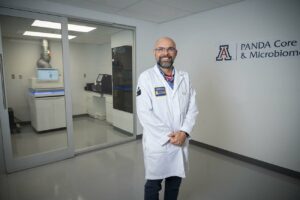Devices allow Health Sciences and other college collaborators greater scale and cost-effective methods to improve care.
 Anna Williams prepares to load a flow cell into the PANDA Core for Genome and Microbiome Research’s NovaSeq 6000 genome sequencer. The flow cell is what DNA samples are pumped into and what they bind to as they’re processed into sequenced reads. (image: University of Arizona Health Sciences)
Anna Williams prepares to load a flow cell into the PANDA Core for Genome and Microbiome Research’s NovaSeq 6000 genome sequencer. The flow cell is what DNA samples are pumped into and what they bind to as they’re processed into sequenced reads. (image: University of Arizona Health Sciences)
Finding when and where DNA changes as a disease progresses allows for better treatment of chronic, genetic-based diseases including cancer, diabetes, and neurological and developmental disorders.
At the University of Arizona, genome sequencers are used across multiple disciplines. But the newest genome sequencer in the UArizona Health Sciences offers the latest light-year jump in ability and technology.
Expanding capabilities, improving treatment

Daniel Laubitz, PhD, is the director of the PANDA Core for Genomic and Microbiome Research at the Steele Children’s Research Center.
An Illumina NovaSeq 6000 System was purchased by the Steele Children’s Research Center Phoenix women’s board known as People Acting Now Discover Answers. The $1.3 million genome sequencer was installed last July at the center’s PANDA Core for Genomics and Microbiome Research in the Department of Pediatrics at the College of Medicine – Tucson. The center operates as the department’s research arm.
“NovaSeq gives us completely new scale of sequencing,” said PANDA Core Director Daniel Laubitz, PhD.
Dr. Laubitz noted the Human Genome Project sequenced the first genome in 2003, taking 13 years and $3 billion to complete. Since then, genomic research has jumped light years. For instance, the PANDA Core’s older sequencer, an Illumina MiSeq unit, can generate 15 million-20 million reads of small pieces of sequenced DNA. The NovaSeq unit generates 20 billion reads times two, as it is two instruments in one.
“Now, with NovaSeq, we can sequence 48 whole human genomes within 40 hours. Our data can be used for diagnostic and basic science purpose,” Dr. Laubitz said. “The scale is completely different. Technology is completely different.”
Last month, the Steele Center was named beneficiary of Tucson’s Angel Charity for Children 2023 fund-raising campaign, which aims to collect $800,000. With that, five labs and one research office will be remodeled to provide genomic testing for children, said Pediatrics Department Chair and Steele Center Director Fayez Ghishan, MD.
“As a recipient for Angel Charity for Children’s funding, this year is going to be so exciting for kids in this community,” Dr. Ghishan told KVOA News4 Tucson. “Through these labs and the equipment we have, we will start whole genome sequencing to identify sick kids more quickly so the cost for treating them will be significantly lower.”
Advancing basic science, diagnostic possibilities
Dr. Laubitz is working with the UArizona Genetics Core for Clinical Services manager Taylor Edwards, MSc, PhD, to validate the PANDA Core’s NovaSeq capabilities to Clinical Laboratory Improvement Amendment, or CLIA, standards. This certification is a federal requirement before such labs can accept human samples for diagnostic testing. He expects validation to take up to three months or more.

Taylor Edwards, MSc, PhD, is associate staff scientist and clinical laboratory manager at the University of Arizona Genetics Core.
Still, Pediatrics Critical Care Division Chief Katri Typpo, MD, MPH, has already used the PANDA Core’s MiSeq and NovaSeq for multiple research studies, including sequencing genetic samples from children who’ve had surgical repair for congenital heart disease. The goal is to better understand how routine perioperative antibiotics alter the gut microbiome and whether nutrition infants receive after surgery could protect them from negative consequences of antibiotics.
“Specifically, I’m trying to understand if timing and type of nutrition protects against organ dysfunction after surgery,” Dr. Typpo added.
“Having a team of researchers on genomic sequencers means that I can collaborate more closely with the team completing the work to have analysis tailored to my specific needs. It results in better science.”
Dr. Laubitz said the NovaSeq and MiSeq sequencers are available for research outside of pediatrics or health. For NovaSeq, that includes sequencing plant, soil or water samples for environmental and other purposes.
“We help get people to the right instrument or service for the most cost efficient, time efficient way of solving their genetic questions.”
Taylor Edwards, PhD
One PANDA Core example involved a soil microbiome study with UArizona College of Agriculture and Life Sciences researchers in Chile’s Atacama Desert, the driest spot-on Earth, to analyze changes after rainfall. Another example is a study on the role of gut microbiota on arsenic-contaminated soil toxicity led by Pawel Kiela, DVM, PhD, Steele Children’s Research Center associate director, Raina Maier, PhD, UArizona Superfund Research Center director, and CALS microbiologist Paul Carini, PhD.
